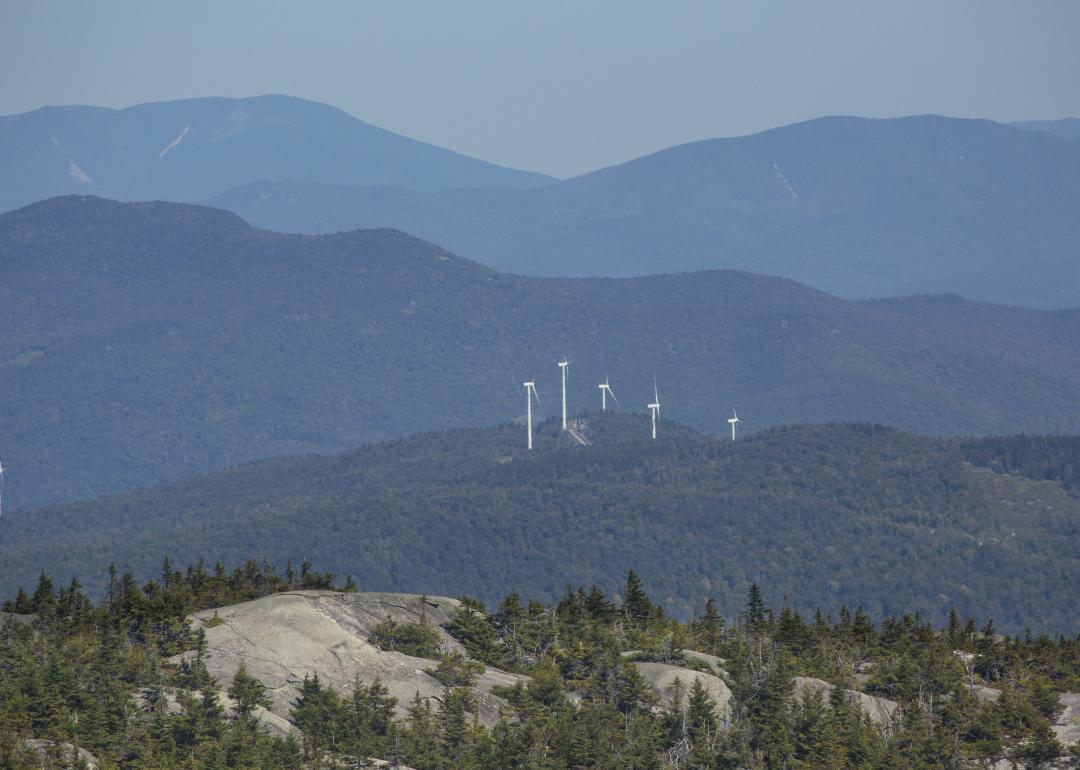
New Hampshire is the #7 state using its wind energy potential most efficiently
New Hampshire is the #7 state using its wind energy potential most efficiently
Wind power is generated when kinetic energy from turbine propellers is converted to mechanical energy.
Even though wind isn't always present, turbines can still actively generate energy 90% of the time through the use of stored energy surpluses. Turbines typically need to be located at higher elevations, where winds tend to be steadier and stronger, but there are alternate ways to utilize wind energy alongside other renewable sources, as has been shown with projects in Oregon and Nevada. Turbines can also be placed on offshore floating platforms, as planned in California.
Using data from the Office of Energy Efficiency and Renewable Energy (EERE), Stacker compared installed wind energy capacity in the continental U.S. to potential wind energy capacity nationally. The EERE calculated wind energy potential through surveying wind patterns at 80 meters throughout the country and selecting suitable wind turbine locations, accounting for legal and technical factors. Stacker also utilized data from the Energy Information Administration to contextualize what percent of electricity generation is currently sourced from wind power in each state.
New Hampshire by the numbers
- Potential wind energy capacity: 12,661 megawatts
- Currently installed wind energy capacity: 214 megawatts
- Current wind energy generation as percent of state's electric grid: 3.1%
Nearby neighbors are frustrated with the visual and auditory impact of New Hampshire wind turbines, even though noise is below state limits. One person compared the sound to "a jet airplane in the distance," noting that he could still hear the sound without his hearing aids.
State policymakers, however, intend to require local utilities to invest in wind energy.
Unions in the state are seeing member interest in wind energy projects, and they want to ask the state for a requirement that future projects utilize New Hampshire labor.
Nationally, the American Jobs Plan sets the intention to achieve carbon-free electricity by 2035, and wind is an obvious component in this game plan.
However, there has been pushback in response to aesthetic and auditory impacts of wind farms, even though many are located miles offshore, and noise is less than that from a close-up, two-person conversation.
Statistics for the national capacity of wind energy in 2017, the most recent data available, stands at almost 85,000 megawatts, versus just short of 17,000 10 years earlier.
Comparatively, potential wind energy stands at 10,640,079 megawatts when collected at an altitude of 80 meters.
Many of the statistics noted here comment on the kilowatt capabilities of the different wind energy projects. For context, the U.S. Energy Information Administration reports that an average U.S. household consumes about 877 kilowatt-hours (kWh) monthly, or more than 10,000 kWh annually.
One notable insight in this state-by-state review of wind energy is there is a dearth of wind energy in many southern states. Reasons for this include insufficient wind in some regions, alongside solar energy availability that makes investment in a new form of renewable energy less appealing.
Continue reading to learn what's happening around the country in terms of wind power.
States with the most untapped wind energy
#1. Texas (using 33,133 of 1,347,992 megawatts)
#2. Montana (using 880 of 678,978 megawatts)
#3. New Mexico (using 2,723 of 652,575 megawatts)
States with the least untapped wind energy
#1. Rhode Island (using 75 of 192 megawatts)
#2. Delaware (using 2 of 755 megawatts)
#3. New Jersey (using 9 of 945 megawatts)



